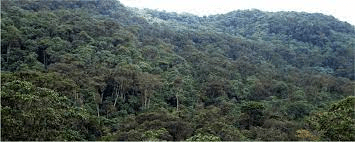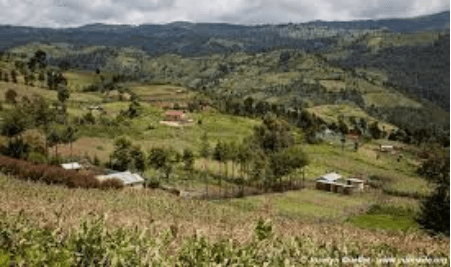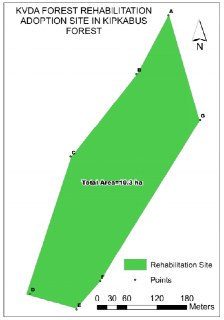Adopt-a-Forest Initiative
KVDA along with key stakeholders are working towards the achievement and maintenance of 10% forest cover nationally. In line with the guidelines from the UN Paris climate change goal and the Ministry of Environment and Forestry objectives, KVDA has rolled out activities under the Adopt-a-Forest Initiative in the Cherangany Watershed and specifically the adoption of the Kipkabus forest as a priority conservation area.
Key activities entail raising of assorted tree seedlings in Authority’s nurseries and supporting other community groups in propagation of selected species of seedlings and, thereafter, roll out tree planting programs in the adopted zone.
-

Cherangany watershed in early 70’s -

Encroachment of Cherangany Watershed & human activities
The Authority has currently raised over 1,000,000 assorted tree and fruit seedlings and 250,000 bamboo seedlings. In collaboration with Kenya Forest Service, the Authority aims to plant 1 million seedlings annually within the adopted zone of the Cherangany Water Catchment. The adopted site is the source of River Kimwarer which serves residents of the Kerio Valley.
The initial activity will involve planting of 10,000 bamboo seedlings on a 10.5 ha of land. The targeted site was once a settlement area but the inhabitants have since been relocated to other areas to pave way for rehabilitation of the site.
-

10.5 ha of land KVDA will plant trees -

Bamboo seedlings
About Cherangany Watershed
Cherangany watershed is one of the five main “water towers” in Kenya. Others are Mt. Kenya, Mt. Elgon, Mau Complex and Aberdare Ranges. The watershed spans across the administrative counties of Elgeiyo Marakwet and West Pokot counties and consists of a large area of forest blocks covering an area of some 120,000 ha. The gazetted forest reserve covers an area of 102,000 ha and the remaining being either private or Trust land forest. A large proportion of the forest cover is made up of indigenous tree species such as bamboo, podo and junipers. In addition, it hosts several faunal and floral Communities that are unique to the ecosystem.
Challenges that Require Intervention
Destruction of Cherangany Watershed has continuously led to severe problems both to the vital forest and the inhabitants. The following activities are responsible for degradation of the watershed:-
- Unwarranted human activities especially logging, have led to deforestation of more than a quarter of the area.
- Deforestation
- Encroachment (for human settlement)
- effects of global warming
Other consequences of degradation have been the closure of industries, loss of employment, reduced agricultural production, food insecurity, loss of livelihoods and loss of revenue to the Treasury due to lower taxation base and poor economic performance.
Overall Goal
Our main objective is conserve, rehabilitate, and protect Cherangany watershed through integrated activities for sustainable natural resource development and socio-economic enhancement of the communities.
Specific Objectives
- To undertake restoration/afforestation of Kipkabus Forest within Cherangany Watershed for future generation. This is aimed at making significant contribution to the national target of 10 per cent tree cover.
- To promote agro-forestry activities for communities living adjacent to the forest aimed at supporting livelihood activities thereby making them self-reliant. Specific activities include planting of early maturing high value crops, beekeeping, livestock improvement etc. These are aimed at increasing household incomes as well as nutritional values for the locals.





